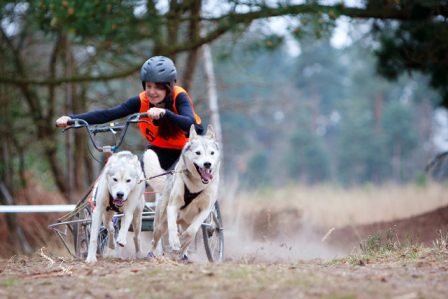A world away from the desolate icy wastelands of Siberia, husky dog racing is alive and well in the rather incongruous setting of the British countryside. Now in its twentieth season, the British Siberian Husky Racing Association was formed by a group of Britain’s leading Sled Dog Drivers in 1996. The rules are stringent; every race is electronically timed to 1/100th of a second and believe it or not, after 5 miles, a race has been decided by 5/100th of a second – here we find out more.
In sled dog racing, men and women can compete on an equal footing, and no matter who is racing, this is fantastic entertainment, for both competitor and spectator. The sport is growing, numbers are increasing and there is a thriving junior competition each year.
Training of young dogs starts at an early age over short distances. When a dog reaches one-year-old, it is allowed to compete in races. A regular training programme is essential for success – in the winter season sometimes four times a week for competitive teams. However, one of the biggest challenges continues to be finding suitable trails in Britain. Husky dogs have been constructed to work and their build is designed to cover as much ground, expend the least energy and suffer the least physical shock and stress as possible.
The design of racing sleds today is very similar to those used in the early days, although modern materials have more or less replaced traditional wood. With this, weight has changed too, from around 50kg for a 4-dog team to some now weighing as little as 15kgs, mild and stainless steel being the preferred materials.
Each dog in the team wears an individually-fitted harness, with attention to comfort around the neck and shoulders. The dogs are hitched to the sled by a central rope known as the ‘gang line’, then with brass clips, the dogs are attached into the lines. Teams are divided into classes based on the number of dogs in the team.
Before the start of the race, it’s highly enjoyable to walk around the rally site. Here you can watch mushers getting their teams ready to run. If time permits, most people love to talk about their dogs, but they have to keep a strict eye on the time as they have specific set times to present at the Start Chute. Each team is released at timed intervals.
Excitement levels are high. The Start Chute is noisy and hectic, but seeing the enthusiasm and eagerness of teams of dogs straining to start the race is an absolute must. The finish line is noisy too but by the end of the race, it’s no longer the huskies making all the noise, but excited family and friends cheering and encouraging their favourite teams across the line. In between the start and finish, out on the trail itself, it is important that spectators stand well back so they don’t alarm the passing teams with any sudden movement. There are marshals at regular intervals along the trails and it is imperative that spectators listen to any instructions they give.
To get the best results from these dogs, not only is training important but the correct diet is essential. Feeding depends very much on the level of exercise but a husky that is working in harness does well on a diet such as Alpha High Performance where meat is the first ingredient and there is the right protein/fat ratio. It is important to store food safely though, to avoid dangerous bingeing, as given the chance, huskies would eat at least five times a day by helping themselves!




